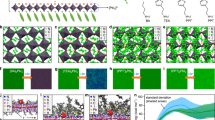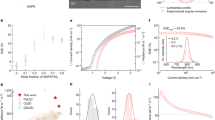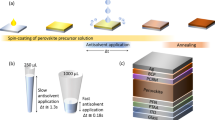Abstract
The efficiency and stability issues of perovskite light-emitting diodes, especially at high brightness, need to be urgently solved for displays and lighting applications. Herein we present a simple chemical washing method called solvent sieve to resolve the phase dimension issue of metal halide perovskites. After being sieved, undesirable defect-rich low-n phases are selectively screened out of perovskite multi-quantum-well structures. With better intrinsic structure refinement, the sieved perovskites demonstrated not only a record external quantum efficiency, current efficiency, and T50 lifetime of 29.5%, 127.4 cd A−1, and 18.67 h at 12,000 cd m−2 (the equivalent of over 50,317 h or 5.7 years at 100 cd m−2), respectively, with a maximum luminance of over 147,872.8 cd m−2, but also extraordinary resistance to air and moisture, maintaining over 75% of film photoluminescence quantum yield and 80% of device EQE after being stored at ambience for 100 days. The simple solvent sieve treatment we reported here confirms the feasibility of metal halide perovskites for luminescence and unleashes the efficiency and stability potentials of high-brightness perovskite light-emitting diodes for future commercial applications.
This is a preview of subscription content, access via your institution
Access options
Access Nature and 54 other Nature Portfolio journals
Get Nature+, our best-value online-access subscription
$29.99 / 30 days
cancel any time
Subscribe to this journal
Receive 12 print issues and online access
$209.00 per year
only $17.42 per issue
Buy this article
- Purchase on Springer Link
- Instant access to full article PDF
Prices may be subject to local taxes which are calculated during checkout




Similar content being viewed by others
Data availability
The data that support the findings of this study are available in the paper, Supplementary Information, as well as from the corresponding authors on reasonable request.
References
Jeon, N. J. et al. Compositional engineering of perovskite materials for high-performance solar cells. Nature 517, 476–480 (2015).
Rajagopal, A. et al. Toward perovskite solar cell commercialization: a perspective and research roadmap based on interfacial engineering. Adv. Mater. 30, e1800455 (2018).
Lee, M. M. et al. Efficient hybrid solar cells based on meso-superstructured organometal halide perovskites. Science 338, 643–647 (2012).
Gratzel, M. The light and shade of perovskite solar cells. Nat. Mater. 13, 838–842 (2014).
Seok, S. I. et al. Methodologies toward highly efficient perovskite solar cells. Small 14, e1704177 (2018).
Kim, Y.-H. et al. Comprehensive defect suppression in perovskite nanocrystals for high-efficiency light-emitting diodes. Nat. Photon. 15, 148–155 (2021).
Tan, Z.-K. et al. Bright light-emitting diodes based on organometal halide perovskite. Nat. Nanotechnol. 9, 687–692 (2014).
Ma, D. et al. Distribution control enables efficient reduced-dimensional perovskite LEDs. Nature 599, 594–598 (2021).
Liu, Z. et al. Perovskite light‐emitting diodes with EQE exceeding 28% through a synergetic dual‐additive strategy for defect passivation and nanostructure regulation. Adv. Mater. 33, 2103268 (2021).
Cho, H. et al. Overcoming the electroluminescence efficiency limitations of perovskite light-emitting diodes. Science. 350, 1222–1225 (2015).
Shi, X. et al. Large-area display textiles integrated with functional systems. Nature 591, 240–245 (2021).
Choi, M. K., Yang, J., Hyeon, T. & Kim, D.-H. Flexible quantum dot light-emitting diodes for next-generation displays. npj Flex Electron. 2, 10 (2018).
Meng, W. et al. Three-dimensional monolithic micro-LED display driven by atomically thin transistor matrix. Nat. Nanotechnol. 16, 1231–1236 (2021).
Stoumpos, C. C. et al. Ruddlesden–Popper hybrid lead iodide perovskite 2D homologous semiconductors. Chem. Mater. 28, 2852–2867 (2016).
Kong, L. et al. Smoothing the energy transfer pathway in quasi-2D perovskite films using methanesulfonate leads to highly efficient light-emitting devices. Nat. Commun. 12, 1246 (2021).
Zhao, B. et al. Efficient light-emitting diodes from mixed-dimensional perovskites on a fluoride interface. Nat. Electron. 3, 704–710 (2020).
Li, P. et al. Low-dimensional Dion–Jacobson-phase lead-free perovskites for high-performance photovoltaics with improved stability. Angew. Chem. Int. Ed. 59, 6909–6914 (2020).
Zhou, M. et al. Manipulating the phase distributions and carrier transfers in hybrid quasi‐two‐dimensional perovskite films. Sol. RRL 3, 1800359 (2019).
Kim, H. et al. Proton-transfer-induced 3D/2D hybrid perovskites suppress ion migration and reduce luminance overshoot. Nat. Commun. 11, 3378 (2020).
Lee, S. et al. Growth of nanosized single crystals for efficient perovskite light-emitting diodes. ACS Nano 12, 3417–3423 (2018).
Liu, N. et al. Understanding the defect properties of quasi-2D halide perovskites for photovoltaic applications. J. Phys. Chem. Lett. 11, 3521–3528 (2020).
Yang, X. et al. Efficient green light-emitting diodes based on quasi-two-dimensional composition and phase engineered perovskite with surface passivation. Nat. Commun. 9, 570 (2018).
Wu, C. et al. Alternative type two-dimensional-three-dimensional lead halide perovskite with inorganic sodium ions as a spacer for high-performance light-emitting diodes. ACS Nano 13, 1645–1654 (2019).
Yang, X. et al. Effects of organic cations on the structure and performance of quasi-two-dimensional perovskite-based light-emitting diodes. J. Phys. Chem. Lett. 10, 2892–2897 (2019).
Guo, Y. et al. Degradation mechanism of perovskite light‐emitting diodes: an in situ investigation via electroabsorption spectroscopy and device modelling. Adv. Funct. Mater. 30, 1910464 (2020).
Hu, S. et al. Light-induced photoluminescence quenching and degradation in quasi 2D perovskites film of (C6H5C2H4NH3)2 (CH3NH3)2[Pb3I10]. Appl. Sci. 11, 2683 (2021).
Na Quan, L. et al. Edge stabilization in reduced-dimensional perovskites. Nat. Commun. 11, 170 (2020).
Liang, C. et al. Two-dimensional Ruddlesden–Popper layered perovskite solar cells based on phase-pure thin films. Nat. Energy 6, 38–45 (2020).
Jiang, Y. et al. Reducing the impact of Auger recombination in quasi-2D perovskite light-emitting diodes. Nat. Commun. 12, 336 (2021).
Chu, Z. et al. Perovskite light-emitting diodes with external quantum efficiency exceeding 22% via small-molecule passivation. Adv. Mater. 33, e2007169 (2021).
Guo, Z. et al. Promoting energy transfer via manipulation of crystallization kinetics of quasi-2D perovskites for efficient green light-emitting diodes. Adv. Mater. 33, e2102246 (2021).
Travis, W. et al. On the application of the tolerance factor to inorganic and hybrid halide perovskites: a revised system. Chem. Sci. 7, 4548–4556 (2016).
Wei, Y. et al. An overview on enhancing the stability of lead halide perovskite quantum dots and their applications in phosphor-converted LEDs. Chem. Soc. Rev. 48, 310–350 (2019).
Zhu, J. et al. Formamidine disulfide oxidant as a localised electron scavenger for >20% perovskite solar cell modules. Energy Environ. Sci. 14, 4903–4914 (2021).
Lei, L. et al. Efficient energy funneling in quasi-2D perovskites: from light emission to lasing. Adv. Mater. 32, e1906571 (2020).
Sidhik, S. et al. Deterministic fabrication of 3D/2D perovskite bilayer stacks for durable and efficient solar cells. Science 377, 1425–1430 (2022).
Krückemeier, L. et al. Understanding transient photoluminescence in halide perovskite layer stacks and solar cells. Adv. Energy Mater. 11, 2003489 (2021).
Rothmann, M. U. et al. Atomic-scale microstructure of metal halide perovskite. Science 370, eabb5940 (2020).
Yuan, M. et al. Perovskite energy funnels for efficient light-emitting diodes. Nat. Nanotechnol. 11, 872–877 (2016).
Woo, S.-J. et al. Characterization of stability and challenges to improve lifetime in perovskite LEDs. Nat. Photon. 15, 630–634 (2021).
Zhao, L. et al. Thermal management enables bright and stable perovskite light‐emitting diodes. Adv. Mater. 32, 2000752 (2020).
Dong, Q. et al. Operational stability of perovskite light emitting diodes. J. Phys. Mater. 3, 012002 (2020).
Liu, S. et al. Passivation of metal oxide surfaces for high-performance organic and hybrid optoelectronic devices. Chem. Mater. 27, 2532–2539 (2015).
Xiang, C. et al. High efficiency and stability of ink-jet printed quantum dot light emitting diodes. Nat. Commun. 11, 1646 (2020).
Bangsund, J. S. et al. Sub–turn-on exciton quenching due to molecular orientation and polarization in organic light-emitting devices. Sci. Adv. 6, abb2659 (2020).
Acknowledgements
This work was supported by the National Key Research and Development Program of China (grant no. 2022YFB3602902 to C.X.), Zhejiang Provincial Natural Science Foundation of China (grant no. LR21F050001 to C.X.), the Key projects of National Natural Science Foundation of China (grat no. 62234004 to C.X.), Ningbo 3315 Programme (grant no. 2020A-01-B to L.Q.), Ningbo Key Technologies R & D Program (grant no. 2022Z085 to Z.T.) and YONGJIANG Talent Introduction Programme (grant no. 2021A-038-B to C.X.). S.D. acknowledged Zhiwei Yao from NIMTE and Shichen Yin from North Carolina State University for experimental discussion. We are grateful for the technical support for Nano-X from Suzhou Institute of Nano-Tech and Nano-Bionics, Chinese Academy of Sciences (SINANO). The paper was dedicated in memory of Lei Qian, who was a great mentor, colleague and friend. He made many significant scientific contributions during his highly productive career and will be remembered.
Author information
Authors and Affiliations
Contributions
S.D. and C.X. conceived the study. S.D. developed the solvent sieve method, fabricated light-emitting devices, and performed EQE and stability tests. S.D. and Z.T. characterized perovskite properties. Q.W., W.G. and B.Z. assisted perovskite fabrication and device optimization. C.W. and Xuanyu Zhang assisted perovskite characterization and data analysis. H.C. and Xinyu Zhang advised on project design. R.C. and T.C. conducted TAS tests. C.X. and L.Q. supervised the project. L.Q. served as the corresponding author throughout production of the paper. All authors discussed the results and commented on the paper.
Corresponding author
Ethics declarations
Competing interests
The authors declare no competing interests.
Peer review
Peer review information
Nature Photonics thanks Takayuki Chiba and the other, anonymous, reviewer(s) for their contribution to the peer review of this work.
Additional information
Publisher’s note Springer Nature remains neutral with regard to jurisdictional claims in published maps and institutional affiliations.
Supplementary information
Supplementary Information
Supplementary Figs. 1–22, Tables 1–4 and Notes 1 and 2.
Rights and permissions
Springer Nature or its licensor (e.g. a society or other partner) holds exclusive rights to this article under a publishing agreement with the author(s) or other rightsholder(s); author self-archiving of the accepted manuscript version of this article is solely governed by the terms of such publishing agreement and applicable law.
About this article
Cite this article
Ding, S., Wang, Q., Gu, W. et al. Phase dimensions resolving of efficient and stable perovskite light-emitting diodes at high brightness. Nat. Photon. 18, 363–370 (2024). https://doi.org/10.1038/s41566-023-01372-0
Received:
Accepted:
Published:
Issue Date:
DOI: https://doi.org/10.1038/s41566-023-01372-0



